Abstract
Effect of oxide level on porosity formation in an A356 alloy was investigated using micro-focus X-ray imaging and directional solidification technology. The increase of oxide level in liquid aluminum was achieved by violently stirring molten metal at elevated temperature. During solidification, the increased oxide content in melt significantly increases the amount of active nucleation sites for porosity and thus raises the nucleation temperature of pores. The fast growth of those early formed pores further restrains the succeeding nucleation operations of new pores in local regions and results in a considerable reduction in pore density. It was also found that the melt with high oxide content shows less dependency of growth rate reduction with local temperature.
Access this chapter
Tax calculation will be finalised at checkout
Purchases are for personal use only
Preview
Unable to display preview. Download preview PDF.
Similar content being viewed by others
References
R. C. Atwood, S. Sridhar and P. D. Lee, “Equations for nucleation of hydrogen gas pores during solidification of aluminium seven weight percent silicon alloy,” Scripta Mater., 41(12) (1999), 1255–1259.
C. D. Lee, “Tensile properties of high-pressure die-cast AM60 and AZ91 magnesium alloys on microporosity variation,” J. Mater. Sci., 42(24) (2007), 10032–10039.
Q.G. Wang, D. Apelian and D. A. Lados, “Fatigue behavior of A356–T6 aluminum cast alloys. Part I. Effect of casting defects,” Journal of Light Metals, 1 (2001): 73–84.
J. Y. Buffière et al., “Experimental study of porosity and its relation to fatigue mechanisms of model Al-Si7-Mg0.3 cast Al alloys,” Mater. Sci. Engn. A, 316(1–2) (2001), 115–126.
J. Z. Yi et al., “Statistical modeling of microstructure and defect population effects on the fatigue performance of cast A356-T6 automotive components,” Mater. Sci. Engn. A, 432 (1–2) (2006), 59–68.
L. Dietrich and J. Radziejewska, “The fatigue damage development in a cast Al–Si–Cu alloy,” Materials and Design, 32 (2011), 322–329.
J.B. Jordon et al., “Microstructural Inclusion Influence on Fatigue of a Cast A356 Aluminum Alloy,” Metall. Mater. Trans. A, 41 (2010), 356–363.
De-Feng Mo et al., “Effect of microstructural features on fatigue behavior in A319–T6 aluminum alloy,” Mater. Sci. Engn. A, 527 (2010), 3420–3426.
J. Campbell, “Castings,” Butterworth-Heinemann, 2003.
X. G. Chen and S. Engler, “Formation of Gas Porosity in Aluminum Alloys,” AFS Trans., 102 (1994), 673–682.
P. S. Mohanty, F. H. Samuel and J. E. Gruzleski, “Mechanisum of heterogeneous nucleation of pores in metals and a1loys,” Metall. Mater. Trans. A, 24 (1993), 1845–1856.
P. S. Mohanty, F. H. Samuel and J. E. Gruzleski, “Experimental study of pore nucleation by inclusions in a1umiaum casings,” AFS Trans., 103 (1995), 555–564.
G. Laslaz and P. Laty, “Gas Porosity and Metal Cleanliness in Aluminum Casting Alloys,” AFS Trans., 99 (1991), 83–90.
X. G. Chen and J. E. Gruzleski, “Influence of Melt Cleanliness on Pore Formation in Aluminum-Silicon Alloys,” Cast Metals, 9 (1996), 17–26.
R. Fuoco, E. R. Correa and M. de Andrade Bastos, “Microporosity morphology in A356 aluminum alloy in unmodified and in Sr modified conditions,” AFS Trans., 108 (2001), 659–768.
K. Tynelius, J. F. Major and D. Apelian, “A Parametric Study of Microporosity in the A356 Casting Alloy System,” AFS Trans., 101 (1993), 401–13.
O. Savas and R. Kayikci, “Application of Taguchi’s methods to investigate some factors affecting microporosity formation in A360 aluminum alloy casting,” Mater. & Design, 28(7) (2007), 2224–2228.
J. R. Kim and R. Abbaschian, “Influence of processing variables on microporosity formation in Al-4.5% Cu alloy,” TMS Annual Meeting, Frontiers in Solidification Science — Proceedings of Symposium, held during the 2007 TMS Annual Meeting, 2007, p 35–45.
L. Omid et al., “X-ray microtomographic characterization of porosity in aluminum alloy A356,” Metall. Mater. Trans. A, 40(4) (2009), 991–999.
P. D. Lee and J. D. Hunt, “Hydrogen porosity in directional solidification aluminum-copper alloys: in situ observation,” Acta Mater., 45(10) (1997), 4155–4169.
R.C. Atwood et al., “Diffusion-controlled growth of hydrogen pores in aluminum-silicon castings: in situ observation and modelling,” Acta Mater. 48 (2000), 405–417.
L. Zhao et al., “In-situ observation of porosity formation during directional solidification of Al-Si Casting Alloys,” China Foundry, 8(1) (2011), 14–18.
L. Zhao et al., “Abnormal segregation induced by gas pores during solidification of Al-Sn alloy,” Scripta Mater., 65 (2011), 795–798.
Author information
Authors and Affiliations
Corresponding author
Editor information
Editors and Affiliations
Rights and permissions
Copyright information
© 2012 TMS (The Minerals, Metals & Materials Society)
About this paper
Cite this paper
Liao, H., Song, W., Wang, Q., Zhao, L., Fan, R. (2012). Effect of Oxide Level on Pore Formation in A356 Alloy by X-Ray Imaging and Directional Solidification Technology. In: Weiland, H., Rollett, A.D., Cassada, W.A. (eds) ICAA13 Pittsburgh. Springer, Cham. https://doi.org/10.1007/978-3-319-48761-8_221
Download citation
DOI: https://doi.org/10.1007/978-3-319-48761-8_221
Publisher Name: Springer, Cham
Print ISBN: 978-3-319-48225-5
Online ISBN: 978-3-319-48761-8
eBook Packages: Chemistry and Materials ScienceChemistry and Material Science (R0)




